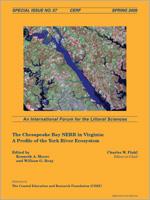Special Issue 57 - The Chesapeake Bay NERRS in Virginia: A Profile of the York River Ecosystem [Moore & Reay]
PREFACE (1)
ACKNOWLEDGEMENTS (1)
ARTICLES (12)

No abstract available
No abstract available
